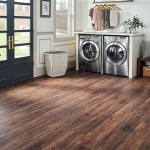Vinyl flooring is a popular choice for many homeowners due to its durability, low maintenance, and affordability. Rolls of vinyl flooring offer a convenient and cost-effective way to cover large floor surfaces. In this article, we will explore the benefits and drawbacks of using rolls of vinyl flooring, different types of vinyl flooring available, and tips for installing and maintaining your vinyl flooring.
Benefits of Rolls of Vinyl Flooring
Rolls of vinyl flooring offer many benefits compared to other types of flooring. They are a great choice for areas that are prone to moisture, such as bathrooms and kitchens, as vinyl is water resistant. Vinyl also provides a softer surface than ceramic or stone tiles, making it more comfortable to walk on. Additionally, vinyl is easy to install and maintain, making it a great choice for DIYers. Rolls of vinyl flooring also come in a variety of colors, patterns, and textures, so you can customize the look of your home.
Types of Vinyl Flooring
When it comes to vinyl flooring, there are several different types to choose from. Sheet vinyl is the most common type, and comes in large rolls measuring 12 feet wide. Plank vinyl is available in strips that are usually 4 to 8 feet in length, and can be installed in a variety of patterns. Tile vinyl is cut into individual squares, which makes it easier to install in hard-to-reach areas. Finally, luxury vinyl tile (LVT) is a newer option that combines the look of natural stone and wood with the durability and affordability of vinyl.
Installing Rolls of Vinyl Flooring
Installing rolls of vinyl flooring is a relatively easy process, but it is important to prepare the area properly before beginning. Start by removing all furniture, appliances, and other objects from the room, and then clean the subfloor. Make sure the surface is dry and level before laying the vinyl, as any bumps or dips can cause the floor to warp over time. Once the subfloor is ready, you can begin to install the vinyl. Start in a corner and unroll the vinyl, cutting off any excess with a utility knife. Use a roller to press the vinyl down, making sure to smooth out any air bubbles as you go.
Maintaining Your Vinyl Flooring
Maintaining your vinyl flooring is easy. Start by sweeping or vacuuming regularly to prevent dirt and debris from accumulating. If you notice any stains, use a mild detergent and warm water to clean the area. Avoid using abrasive cleaners or scrubbing too hard, as this may cause the finish to become dull over time. Additionally, use non-staining mats and rugs in areas that are prone to spills, such as the kitchen or bathroom.
Things to Consider Before Buying Vinyl Flooring
Before buying rolls of vinyl flooring, there are a few things to consider. First, decide on a budget and determine your needs. Sheet vinyl is the most affordable option, while luxury vinyl tile is more expensive but offers a higher-end look. Additionally, consider the size of the room and the amount of traffic it receives. Vinyl is durable and long-lasting, but it may need to be replaced sooner in areas with high foot traffic.
Conclusion
Rolls of vinyl flooring are a great option for many home improvement projects. They are easy to install and maintain, and come in a variety of colors, patterns, and textures. Before buying vinyl flooring, consider your budget and the size and traffic of the room. With the proper care and maintenance, your vinyl flooring will last for years to come.















Related Posts








